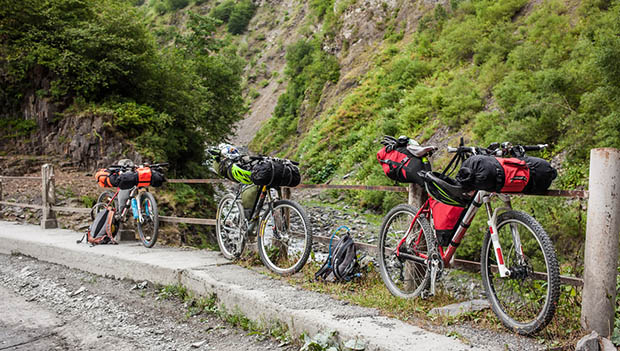
It's no secret that cyclists have a renewed love affair with taking their bikes off-road. From cyclocross to gravel rides, getting off the pavement not only limits your interactions with cars, but it's also a great way to explore less-traveled routes.
Bikepacking is another such format and is essentially a combination of backpacking and bike touring. A rider carries all the gear they need to not only ride long distances multiple days in a row but camp overnight, too.
As you'd expect, there's a lot that goes into a successful bikepacking experience. From the gear you need to finding the perfect route, here are a few things to keep in mind as you plan your next adventure.
The Gear
Choosing the right setup is a highly personal process, so what works for one person may not be suitable for someone else. However, there are a few general tips that serve as a good foundation and can be customized as you see fit.
Since a bikepacking route can be composed of everything from asphalt and gravel fire roads to singletrack, you need a bike that can do it all. A rigid frame mountain bike is ideal, and make sure the frame in question can mount racks and storage bags. Higher-volume tires are also popular, so shoot for 29- to 27.5-inch wheels and gravel tires (not too knobby yet not too slick).
Once you have a sturdy frame, it's time to outfit it to carry all your gear (a three-pocket jersey isn't enough anymore). Don't get too fancy, though—it's important to stay organized and practical. Add as many water bottle cages as your frame will allow, install a rack (front and rear) and attach panniers to each and a small handlebar bag to—you guessed it—the handlebars.
You can also wear a light daypack if needed, but it's crucial to keep as much weight off your back as possible. This helps with fatigue and back issues but also improves bike handling by keeping the weight lower to the ground.
Next, think about what gear you need to pack. These are just some quick suggestions, but here's a thorough checklist from Bikepacking.com for a variety of setups. You'll need to carry everything you'd usually carry on a backpacking excursion, as well as bike-specific gear. This includes several spare tubes, a pump, multitool, chain tool, spare cables and more. Note that some of these items require a bit of bike maintenance knowledge, so be sure you have the skills to fix your bike before you head out.
The Route
A word of advice: Don't bite off more than you can chew. Start small with simple overnight getaways before you jump into a multiday trip. Also, stay local until you get the hang of it. Nearby forest-service roads or state parks are two great places to start.
Make a shortlist of routes you'd like to explore, but before you commit to an itinerary, look up weather forecasts for the area so you can customize your gear for a specific temperature or dodge a hazardous weather pattern altogether. Time of year can make a big difference, especially in areas with unpredictable weather or extreme conditions.
Next, plan your route. This is easier said than done, but there are tons of guidebooks and online resources for bikepacking routes in specific areas that outline where you can and can't camp and will show you the elevation profile, difficulty and other helpful information. Don't just think about how many nights you'd like to include; also consider how many miles you're willing to ride each day. This is an important component for deciding where you'll set up camp each night, too.
If you're just doing a quick overnighter, you can likely pack all the water and food you need right on your bike. But if you're planning on a longer adventure, be sure to consider where you'll have access to water (don't forget a purification system) and food along the route. A small detour to a local grocery store or mini mart can be a serious morale booster.
Have you checked out a few guidebooks and are still unsure what's best for you? The bikepacking community is a supportive group of enthusiasts, so don't hesitate to talk with a ranger or a fellow bikepacker to be pointed in the right direction. The goal here is to have fun and explore new areas on two wheels, so don't be afraid to ask questions or join a group for your first few adventures.
Are you planning a bikepacking adventure? We'd love to hear about it—leave us a comment below!
READ THIS NEXT: Why the Do-It-All Bike Has Become So Popular


